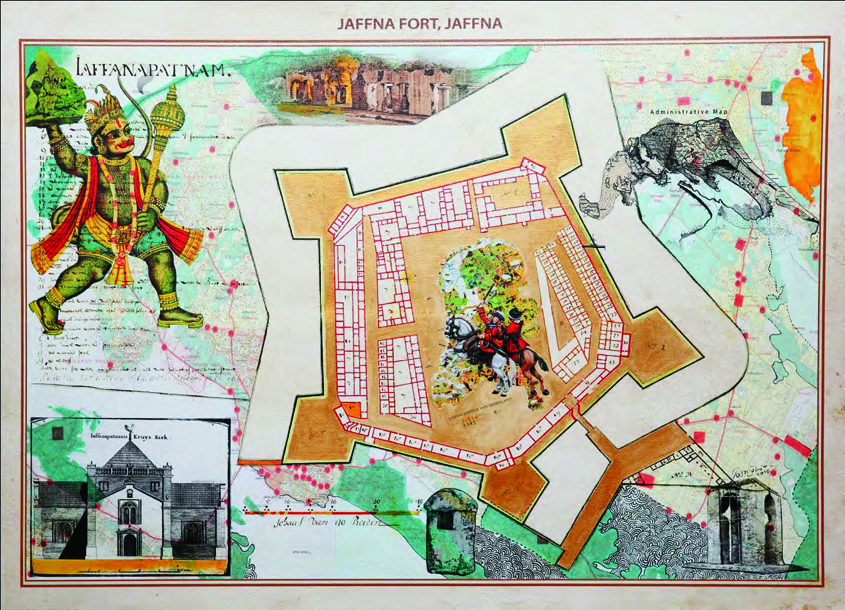Delhi-based art gallery Blueprint 12 will showcase works of four artists from South Asia at the India Art Fair from 2-5 February. The artists are from India, Bangladesh, Nepal and Sri Lanka. Works of artists Subrat Kumar Behera (from India), Mahbubur Rahman (Bangladesh ), Pala Pothupitye (Sri Lanka) and Youdhishtir Maharjan (Nepal) will be exhibited. According to director Mandira Lamba, the works will encourage a conversation across borders. She says, “The selection of works, based on the concept of ‘belonging’ and ‘identity’ weave stories of colonisation, fantasy and socio-political issues in these regions.”
An artist from Sri Lanka, Pala Pothupitye has worked on a project using maps. He has re-crafted their generally accepted “social” context and has focused on the “historical evolution” of various regions. In his work Fort Jaffna, he has played with a digital print of a fort and effectively re-drawn it. The artist has emphasised the place as an institution of power which is held by the colonisers. It seems that Pothupitye is trying to critique the outside influences foisted on the island. His prime focus is on identity. He says, “My artistic energy tends to explore a number of interpretations on identity. They can range within the discourse of ancestry, tradition, authenticity, urbanity, geo-politics and the like inside the dynamics of contemporary art practices.”

One of the main artists at Kochi Muziri’s Biennale 2016, Subrat Kumar Behera is also a part of this endeavour by Gallery Blueprint. His work, The Eternal Dance of Tribal Drama represents in a sense performing arts. Here one can see traditional dancers, some of which are Gauri dancers and some are the Chhau dancers from Orissa’s Mayurbhanj. These lithographs are connected with each other and each depicts traditional Indian dancers and deities along with imaginary animals. Behera says, “My art has a lot to with the creation of a fantasy world that the spectator enters. I unleash my imagination and let my make-believe unfold one after the other in this real world. It is a space that transcends the limitations of physical reality; limitations that could otherwise become barriers in the expression of my thoughts and skills.”
Long Walk to Freedom, by Nepal-born artist Youdhishtir Mahajan, is a work that is made using a book. Here the artist has erased all the text in Nelson Mandela’s autobiography Long Walk to Freedom except for the periods.
Mahbubur Rahman is one the most prominent and prolific voices from Bangladesh. He dabbles in various mediums like video, painting, sculpture and performance, to bring out the suffering and unease of Bangladeshi citizens. Lonely King, a sculpture him showcased at the fair, speaks of our society where we worship power and money. One gains more power when one serves and meets others’ wishes. The artist has reinforced his view that like the consumer world, we live in an aggressive society, where someone can be reduced to an insignificant entity easily. He says, “Lonely King is a story about people where everybody is king in his own dream-world unless certain dreams are shattered. My involvement with art and activism, and my observation of political and social conflicts result from a hunger to search for a genuine Bangladeshi identity in the 21st century. This search has taken me across mediums and ideas, transcending boundaries that were created by orthodox academic institutions and fundamentalist political ideologies.”

Long Walk to Freedom, by Nepal-born artist Youdhishtir Mahajan, is a work that is made using a book. Here the artist has erased all the text in Nelson Mandela’s autobiography Long Walk to Freedom except for the periods. Mahajan has dismantled the book’s text to form a scroll and has connected the periods to form one long line which is nearly 180ft long. This rhythmic and arduous task has brought the artist’s mind to a state of meditative stillness, an eternal nothingness. “I am interested in the idea of Sisyphean eternity, monotonous repetition of the same labour over and over again, with no hope or expectation for an end. In the process, I experience different kind of eternity, the sweet kind, which lasts for few material moments, but feels like forever, where the time stops, and with it, stop all my questions and worries, where I am free from my existential burden and get a little closer to myself.”

